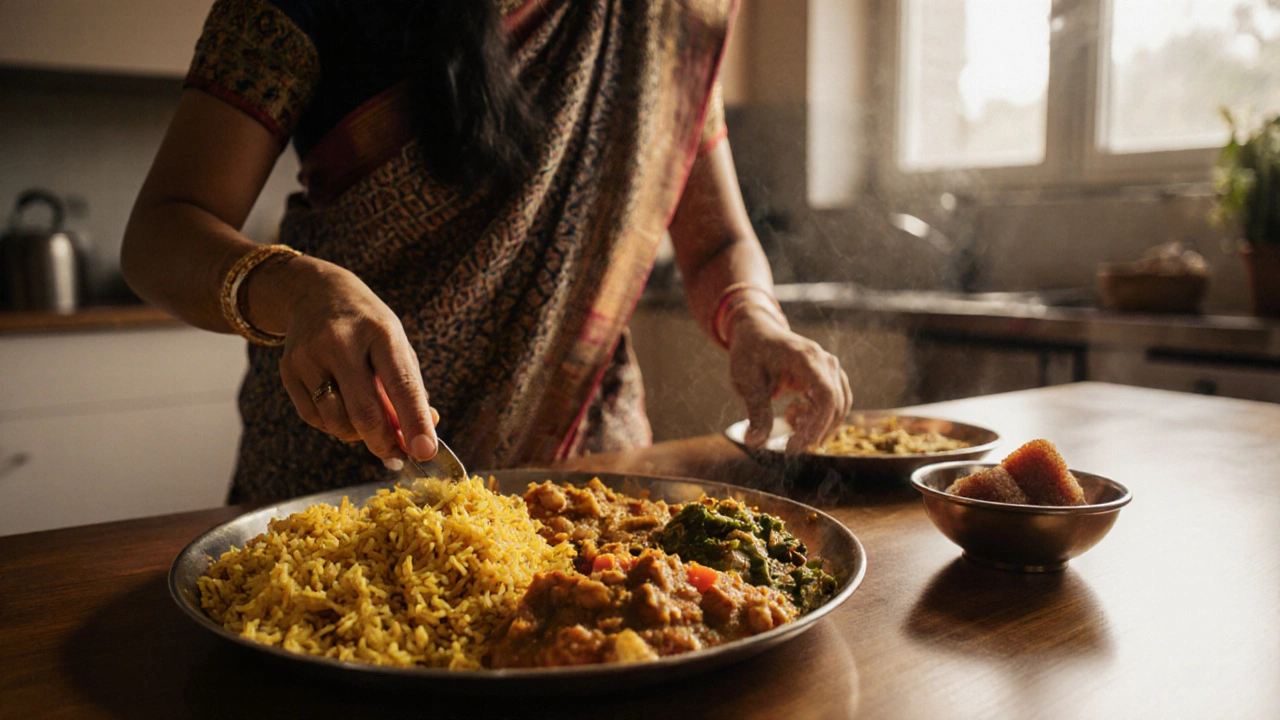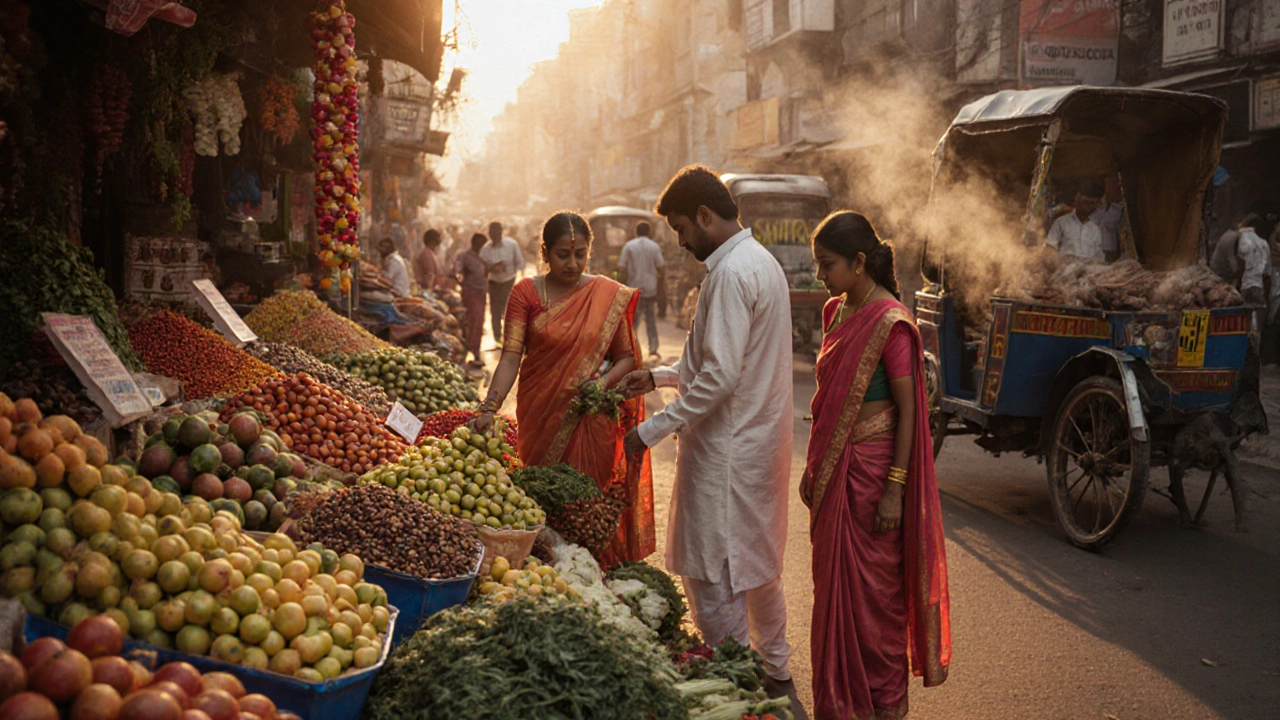India's Vegetarian Faith Quiz
1. Which religion has the highest percentage of vegetarians in India?
2. What is the approximate percentage of Hindus who are vegetarian?
3. Why do Jains avoid root vegetables?
When you think of India, you probably picture spice‑laden dishes, bustling markets, and a kaleidoscope of festivals. But beneath the flavors lies a surprising question: which faith actually leads the nation’s vegetarian count? The answer isn’t just a trivia fact; it shapes daily meals, market trends, and even wildlife protection policies.
Across the subcontinent, food choices are rarely about taste alone. They’re woven into centuries‑old scriptures, ethical vows, and community rituals. Understanding which religion pushes the most people onto plant‑only plates helps anyone-from a home cook to a food‑industry analyst-make sense of the nation’s culinary landscape.
Quick Take
- Jainism has the highest vegetarian adherence, with over 90% of its followers avoiding meat, eggs, and even root vegetables.
- Hinduism, the largest religion, shows a wide spectrum: about 40% of Hindus are vegetarian, largely influenced by the principle of Ahimsa non‑violence toward all living beings.
- Sikhism and Buddhism adopt moderate vegetarian practices, often linked to health and compassion rather than strict bans.
- Islam and Christianity in India exhibit the lowest vegetarian rates, reflecting broader global dietary norms.
- Overall, roughly 30% of India’s 1.4billion people follow a vegetarian diet, making the country the world’s biggest vegetarian market.
What Vegetarianism Means in the Indian Context
Vegetarianism the practice of abstaining from meat, fish, and often eggs in India is not a monolith. It ranges from strict Jain bans on root vegetables-because pulling a plant kills it-to flexible Hindu customs that allow fish on certain festivals. These variations stem from two core ideas: the spiritual goal of reducing harm (Ahimsa) and the cultural belief that a plant‑based diet promotes purity (Sattva).
Jainism - The Strictest Vegetarian Tradition
Jainism an ancient Indian religion emphasizing extreme non‑violence toward all living beings stands out as the most vegetarian. Jains follow a diet that excludes:
- All meat and fish
- Eggs and dairy from non‑vegetarian animals
- Root vegetables (onions, garlic, potatoes, carrots) because harvesting them kills the plant
Statistical surveys by the Jain Vishva Bharati University (2022) show that 94% of Jain households are fully vegetarian, and 72% avoid even root vegetables. This commitment is reinforced by scriptures such as the *Mahavira’s Acaranga Sutra*, which frames food choices as a direct path to spiritual liberation.
Hinduism - A Spectrum of Practices
Home to about 80% of India’s population, Hinduism a diverse set of beliefs and practices anchored in texts like the Vedas and Bhagavad Gita showcases the widest range of dietary habits.
Key drivers:
- Ahimsa: Many Hindus adopt vegetarianism during festivals (Navratri, Ekadashi) or as a lifelong practice.
- Sattvic diet: Belief that plant‑based foods increase mental clarity and spiritual purity.
- Regional influence: Coastal states (Kerala, West Bengal) eat more fish, while inland states (Gujarat, Rajasthan) lean heavily vegetarian.
According to the 2019 Pew Research Center report, roughly 38% of Hindus identify as vegetarian, though the figure climbs to 55% in states like Gujarat and Uttar Pradesh where cultural norms favor plant‑based meals.

Sikhism and Buddhism - Moderate Vegetarianism
Sikhism a monotheistic faith founded in the 15th century Punjab region does not mandate vegetarianism, but the community’s *langar* (community kitchen) traditionally serves vegetarian dishes to ensure everyone can eat together, regardless of personal beliefs. Surveys from the Sikh Research Institute (2021) indicate that about 30% of Sikhs adopt a vegetarian diet full‑time.
Similarly, Buddhism a philosophy and religion that emphasizes compassion for all sentient beings encourages meat‑free meals, especially among monastic orders. In India’s Buddhist pockets (e.g., Ladakh, Sikkim), roughly 45% of lay followers avoid meat, citing the *Five Precepts* which include abstaining from harming living creatures.
Islam and Christianity - Lesser Vegetarian Tendencies
While both religions are minorities in India, their dietary customs largely follow global patterns: meat, especially chicken and lamb, forms a staple part of festive meals. A 2020 survey by the Indian Council of Social Science Research found that only 12% of Indian Muslims and 8% of Indian Christians identify as vegetarian, reflecting fewer scriptural prohibitions against meat.
Numbers at a Glance
| Religion | Population Share in India | Typical Vegetarian % | Scriptural Basis | Common Restrictions |
|---|---|---|---|---|
| Jainism | ~0.4% | 94% | Mahavira’s teachings on Ahimsa | No meat, eggs, root veg |
| Hinduism | ~79.8% | 38‑55% (regional) | Vedas, Bhagavad Gita, Ahimsa | Varies; fish often allowed |
| Sikhism | ~1.7% | ~30% | Guru Granth Sahib (langar principle) | Mostly meat‑free in communal meals |
| Buddhism | ~0.7% | ~45% | Five Precepts, Mahayana sutras | Avoid meat; some eat dairy |
| Islam | ~14.2% | 12% | Qur’an (permissible meat) | No pork; halal meat required |
| Christianity | ~2.3% | 8% | Bible (no explicit bans) | None specific; cultural choices |
How Religious Doctrine Shapes Everyday Meals
Religions don’t just dictate what’s on the plate; they influence when and why food is prepared. For instance, Jain households often start the day with a *prasadam* of fresh fruits, while Hindu families might observe *Vrata* (fast) days that end with a hearty *sabzi* and *roti* spread. Sikh *langar* kitchens serve simple dal, rice, and seasonal vegetables to uphold equality. These practices create distinct market demands-spices for vegetarian curries, legumes for dal, and dairy substitutes for Jain homes that avoid certain dairy products.
Takeaways for Home Cooks and Food Entrepreneurs
If you’re looking to cater to India’s most vegetarian audience, focus on:
- Root‑vegetable‑free recipes for Jain consumers.
- Region‑specific vegetarian staples (e.g., *dhokla* in Gujarat, *idli* in South India).
- High‑protein plant foods-lentils, chickpeas, soy-to meet nutrition needs without meat.
- Transparent labeling that mentions “Jain‑friendly” or “Ahimsa‑approved”.
Understanding which faith drives vegetarian habits helps you tailor flavors, packaging, and even marketing language. Whether you’re whipping up a weekday dal for a Hindu family or designing a café menu for Jain tourists, the religious backdrop can make or break your dish’s success.

Frequently Asked Questions
Which religion has the highest percentage of vegetarians in India?
Jainism leads by a wide margin-over 90% of Jains are strict vegetarians, avoiding meat, eggs, and even root vegetables.
Do all Hindus eat vegetarian?
No. Hindu dietary practices vary by region, caste, and personal belief. About 38% of Hindus are vegetarian nationwide, rising to 55% in some states.
Why do Jains avoid root vegetables?
Root vegetables are excluded because pulling them from the ground kills the entire plant, which conflicts with the Jain principle of minimizing harm to all living beings.
Is Sikh cuisine vegetarian?
Sikhism doesn’t require vegetarianism, but the communal kitchen (*langar*) serves only vegetarian meals so everyone can eat together regardless of personal diet.
How does vegetarianism affect the Indian food market?
With roughly 30% of the population following a vegetarian diet, India is the world’s largest market for plant‑based foods, driving demand for legumes, dairy alternatives, and meat‑free snack innovations.
